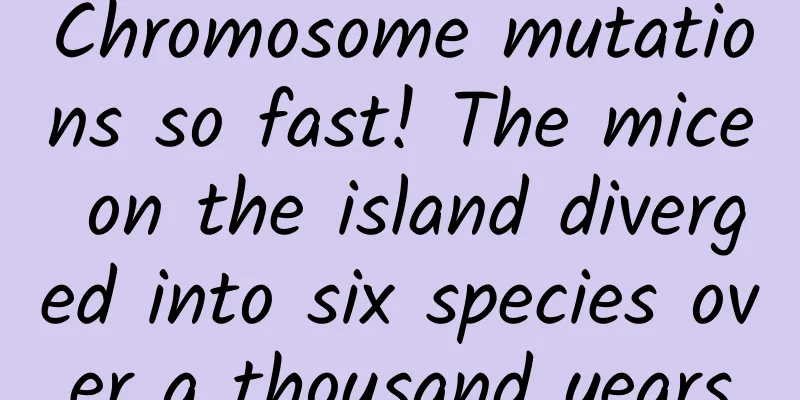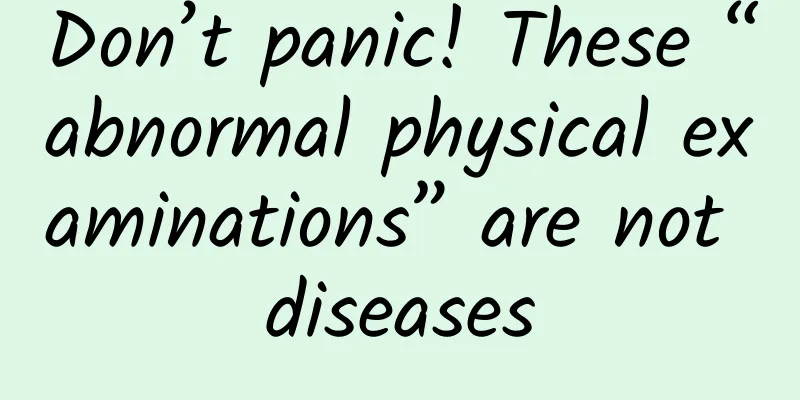Chromosome mutations so fast! The mice on the island diverged into six species over a thousand years

|
Evolution never stops and screening is everywhere. Written by | Yubao Figure 1: Madeira rat. Source: Sofia Gabriel Rapid mutation: Six new species formed in a thousand years On the Portuguese island of Madeira, there live six species of mice that look similar, which can be called Madeira mice. Although they look very similar, they are reproductively isolated, that is, they cannot mate with each other under natural conditions, or cannot produce fertile offspring after mating, which meets the biological criteria for dividing new species, so these six mice belong to different species. Scientists have found that these six types of mice have evolved over the past thousand years; a thousand years ago, they had a common ancestor. A Nature paper in 2000[1] increased the academic community's interest in the study of Madeira mice, and Madeira Island subsequently became another holy place for studying biological evolution, just like the Galapagos Islands in the Pacific. As we all know, it was after seeing the unique species of tortoises and Darwin finches on the Galapagos Islands that Darwin, who participated in an ocean voyage in 1835, gradually formed the theory of biological evolution or the theory of evolution. Figure 2: Madeira Islands belong to Portugal, with a population of about 250,000, and is located 1,077 kilometers southwest of mainland Portugal. The longest part of the island is 57 kilometers and the widest part is 22 kilometers. 丨Source: Wikipedia What is so special about the mice living on Madeira Island? Scientists have found that the number of their genes is not much different, but the structure and number of chromosomes are different. This shows that the evolution of Madeira mice is not through genetic mutation, but through chromosomal variation, which we rarely hear about. The number of chromosomes of ordinary laboratory mice (Mus musculus) is 20 pairs of 40, while the number of chromosomes of Madeira mice is between 22-40. Most mutated Madeira mice have difficulty in producing the next generation, either dying in the embryonic stage or dying after birth due to various defects. The few that can reproduce and adapt to the local environment will retain the mutation, which is the six species of Madeira mice we see now. Robertsonian translocation: It also created humans With the help of chromosome banding technology, scientists can easily find various numerical and structural variations of chromosomes in the laboratory. The main reason for the chromosome differences in Madeira mice is the occurrence of Robertsonian translocation, also known as Robertsonian translocation. Figure 3: Distribution of Robertsonian translocations in Madeira rats. Robertsonian translocations are very common in a population, but most translocations are not passed on to the next generation. [1] Robertobasal translocation refers to the fusion of the long arms of two chromosomes into one chromosome, with the loss of the short arm. During the metaphase of cell division, the centromere of some chromosomes is located at one end of the chromosome, and the short arm is extremely short. This type of chromosome is called acrocentric chromosome. Robertobasal translocation often occurs between acrocentric chromosomes. For example, human chromosome 2 was formed by the fusion of two chromosomes through Robertobasal translocation millions of years ago[2] . According to statistics, the incidence of Robertobasal translocation in newborns is one in a thousand [3], and most affected children will have health problems such as Down syndrome and Patau syndrome. Figure 4: Schematic diagram of Robertsonian translocation (created by the author) The situation of Robertsonian translocation in Madeira mice is similar to that in humans: it occurs with a certain probability in the mouse population, and a small number of translocations that do not affect reproduction and health are retained, and then gradually spread in the population, and even form new mouse populations. On this 740 square kilometer island, six types of mice have been identified, and their chromosome karyotypes are obviously different. It is conceivable that with the increase in sampling density or the passage of time, new mouse strains will be discovered/appeared with a high probability. It is speculated that the ancestors of the mice on the island came from Viking pirate ships that docked here a thousand years ago, and another theory is that they came with the ships of Portuguese colonists in the 15th century. In modern times, there are countless cases of species invasion caused by animals that spread around the world with ships or ballast water. Looking back at middle school biology knowledge, one oocyte undergoes two rounds of meiosis to form one egg cell and three polar bodies. The fate of polar bodies is to degenerate and disappear, and only egg cells participate in the fertilization process and individual development. Middle school textbooks state that the characteristics of species chromosome mutations are that they occur randomly without preference, and the proportion of offspring conforms to Mendel's law of inheritance. However, this is not the case with chromosome separation in Madeira mice: during the meiosis of female mice, Robertsonian translocations are likely to be passed on to the next generation with the help of egg cells, rather than entering polar bodies and reaching a "dead end." Because the fate of polar bodies is to degenerate or die, they do not participate in the fertilization process and individual development. Figure 5: The second meiotic division forms an egg cell and three polar bodies; the polar bodies degenerate and die. 丨Source: Internet So why do "large chromosomes" (two long arms fused and the chromosome body larger) that have undergone Robertsonian translocation tend to enter the egg cell rather than the polar body? The answer lies in the centromere. The centromere is a structure in eukaryotic cells that connects the spindle fibers and chromosomes. Studies have found that chromosomes formed after Robertsonian translocations often have higher DNA content and more centromere proteins attached, so "large chromosomes" are more likely to be distributed to egg cells rather than polar bodies. Figure 6: Schematic diagram of chromosomes. ① Chromosome segmentation ② Midsegment, which divides the chromosome into two arms. The midsegment contains the kinetochore, a complex protein that combines the chromosome with the spindle microtubules. ③ Short arm ④ Long arm | Source: Wikipedia Selfish chromosomes are good at "hitchhiking" More than 50 years ago, zoologist Michael JD White proposed that Robertsonian translocations are good at hitching a ride on meiosis and being passed down. He believed that "a few chromosomal rearrangements, such as Robertsonian translocations, can play a role in speciation, giving specific advantages during female meiosis, and thus generating reproductive isolation through these mechanisms." The mechanism of chromosome variation in Madeira mice proves his theory. Is there a similar phenomenon in plants? In fact, before the Madeira rat, scientists had discovered the phenotype of large chromosomes in plants such as corn and yellow monkeyweed. Figure 7: Ab10 mutant corn | Source: Internet In 1942, geneticist Marcus Rhoades discovered[4] that there was a common mutation in chromosome 10 of corn, Ab10, which was also caused by a Robertson translocation. Corn cobs with the Ab10 mutant chromosome were mainly black-grained corn with a small amount of yellow grains, and the probability of black-grained corn cobs appearing was much higher than the random occurrence rate. Rhoades' explanation for this was: The chromosome with Ab10 is more likely to enter the position where it develops into the egg cell (rather than the polar body), so the number of offspring with translocation is larger, and the proportion of offspring does not conform to Mendel's law. Now we know that Ab10 is indeed more likely to enter the egg cell during meiosis, which is similar to the Robertson translocation in Madeira mice. Rhoades' discovery was the first report of the "meiotic drive" phenomenon in history. Meiotic drive refers to the situation where the proportion of offspring deviates from the expected proportion of Mendel's inheritance due to the interference of selfish genes during meiosis. Inspired by the concept of "selfish gene", people call chromosome 10 of corn the "selfish chromosome". It was not until 2018 that a paper explained the mechanism of Ab10 and revealed the core protein KINDR involved in this process and its function**[5]**. Figure 8: One of the common monkey flower varieties (upper left) and the yellow monkey flower (upper right). The wild type of the yellow monkey flower (lower left) has a dominant ratio of 50% eggs, and the ratio of offspring conforms to Mendel's law of inheritance. However, in the mutant yellow monkey flower with Robert's translocation (lower right), 98% of the eggs are mutation carriers, and the ratio of offspring no longer conforms to Mendel's law of inheritance. The inheritance of Mimulus guttatus is another example of the meiotic drive theory. A 2008 paper showed [6] that individuals with large centromeres produced more offspring, and the proportion of dominant homozygous offspring accounted for about 50% of the total number of experimental populations, while according to Mendel's law of inheritance, this proportion should be 25%. The molecules involved in this mechanism include CENP-A and CenH3. Frequent variation: providing fodder for natural selection Through the above cases, we know that the role of centromere in meiosis is very important. Without it, neither meiosis nor mitosis can proceed. So, based on common sense, the gene sequence and protein of centromere should be very conservative in evolution (not easily changed), but the fact is that the centromere proteins and genes of eukaryotes are not conservative and mutate very quickly. Why does this paradox occur? In 2001, a scientist explained [7] that it is because the centromere is involved in meiotic drive. According to this explanation, the gene sequence of the centromere - such as Ab10 in corn - wants to "kidnap" the "machine" that performs the function of chromosome separation, causing this "machine" to continuously produce chromosome mutations, such as producing egg cells with non-integer chromosome multiples. The "harm" of mutations can be large or small, and there are also neutral mutations, not all of which are lethal, so this process has been evolving rapidly and has not disappeared from the population. The phenomenon of meiotic drive also exists in mice. Scientists have found that the expression products (proteins) of Ran and Cdc42, which have GTPase activity, are involved in meiotic drive, affecting the positioning and polarity establishment of the spindle[8]. By hybridizing mice with "large centromeres" and "small centromeres", scientists have found that the chromosomes of mice with "large centromeres" are more likely to enter the egg cell rather than the polar body. Evolution never stops, and selection is everywhere. What is the significance of meiotic drive or "selfish chromosomes" for the evolutionary adaptability of organisms? At least one thing is clear: by regulating the interaction between centromeres and spindle microtubules, homologous chromosomes will have functional differences, providing a continuous source of material for natural selection. Only in this way, when the natural or artificial environment is constantly changing, there will always be some organisms carrying certain mutations that can adapt, gradually creating more strains and even species. You should know that a Robertson translocation millions of years ago separated the ancestors of humans from the ancestors of apes, and apes gradually evolved into today's humans. References [1] Janice BD et al, Rapid chromosomal evolution in island mice. Nature 2000, 403(6766): 158 [2] Paweł Stankiewicz. One pedigree we all may have come from –did Adam and Eve have the chromosome2 fusion? Molecular Cytogenetics 2016, 9:72 [3] Song JP et al. A family with Robertsonian translocation: a potential mechanism of speciation in humans. Mol Cytogenet. 2016, 9: 48. [4] Rhoades M. Preferential segregation in maize. Genetics 1942, 27:395–407. [5] R. Kelly Dawe et al. A Kinesin-14 Motor Activates Neocentromeres to Promote Meiotic Drive in Maize. Cell 2018 173(4), P839-850 [6] Finseth Fret al. Selfish chromosomal drive shapes recent centromeric histone evolution in monkeyflowers. PLoS Genet 2021, 17(4): e1009418. [7] Harmit S Malik et al. Conflict begets complexity: the evolution of centromeres. Cur Opin in Gene & Dev 2002, 12: 711–718 [8] Benoit D et al. Ran GTPase promotes oocyte polarization by regulating ERM Ezrin/ Radixin/ Moesin inactivation. Cell Cycle. 2013 Jun 1;12(11):1672-8. This article is supported by the Science Popularization China Starry Sky Project Produced by: China Association for Science and Technology Department of Science Popularization Producer: China Science and Technology Press Co., Ltd., Beijing Zhongke Xinghe Culture Media Co., Ltd. Special Tips 1. Go to the "Featured Column" at the bottom of the menu of the "Fanpu" WeChat public account to read a series of popular science articles on different topics. 2. Fanpu provides a function to search articles by month. Follow the official account and reply with the four-digit year + month, such as "1903", to get the article index for March 2019, and so on. Copyright statement: Personal forwarding is welcome. Any form of media or organization is not allowed to reprint or excerpt without authorization. For reprint authorization, please contact the backstage of the "Fanpu" WeChat public account. |
>>: We are all pursuing high emotional intelligence, so why do we insist on low entropy in life?
Recommend
Alipay has made the right move by entering the social networking market through social networking
For Alipay , it is neither trying to build a comm...
2023, the hottest year on record?
2023 could be the hottest year on record Recently...
Douyin e-commerce 618 marketing strategy
In another week, the annual Douyin 618 Good Produ...
The Wentian experimental cabin has been relocated, and here come the hard-core knowledge points!
At 12:44 on September 30, after about an hour of ...
Community operation from 0 to 1500+, the 5 key words I summarized
Some people say that a community is a net woven b...
8 Keys for Startups to Find the Best Investors
In the past two years, the relationship between e...
How to monetize short video live streaming? What are the ways to monetize short videos?
Ever since the trend of short video live streamin...
Five little-known facts about peony
(Copyrighted image from the gallery, no permissio...
Electric Technology Car News: Can the Xuanlang, which is very good-looking but not comfortable, and beats the Baojun 730, open up a new pattern for MPVs?
At the Guangzhou Auto Show at the end of last yea...
Bloomberg New Energy Finance: China is the leader in the electric vehicle market
All major players in the global auto industry env...
Zhang Jian's growth path in key customer sales | Compilation
What kind of course is this? "The Road to Gr...
Stop saying it’s okay to be a little fat when you are a kid. Childhood obesity is likely to continue into adulthood!
Review expert: Shen Yingjian, Director of the Nut...
Introduction to Kong Xiangxi: Chongqing Network Optimization Company lists the key points of SEO promotion for you!
Nowadays, many companies choose to do Internet pr...
Team collaboration and MVVM architecture design in iOS
I wrote this article today to serve as a starting...
Dou Shang 6.28 The latest and most comprehensive inappropriate methods on the Internet break and explain more than 20 methods
Doushang 6.28 The latest and most complete Douyin...









